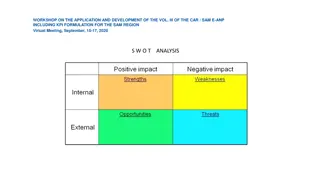Understanding Cross-Sectional Studies: Overview, Strengths, and Weaknesses
Cross-sectional studies are observational study designs that capture data from a population at a specific point in time. This snapshot approach allows for the simultaneous measurement of outcomes and exposures without follow-up. While quick and cost-effective, these studies have limitations such as the inability to establish causality and difficulties in interpreting associations. Sampling methods like probability sampling enhance the study's validity.
Download Presentation

Please find below an Image/Link to download the presentation.
The content on the website is provided AS IS for your information and personal use only. It may not be sold, licensed, or shared on other websites without obtaining consent from the author. Download presentation by click this link. If you encounter any issues during the download, it is possible that the publisher has removed the file from their server.
E N D
Presentation Transcript
Cross-sectional study: Overview A cross-sectional study is a type of observational study design that involves looking at data from a population at one specific point in time. In a cross-sectional study, investigators measure outcomes and exposures of the study subjects at the same time. It is described as taking a snapshot of a group of individuals.
Cross-sectional study: Overview The subjects in a cross-sectional study are chosen from an available population of potential relevance to the study question. Unlike in case-control studies (subjects selected based on the outcome status) or cohort studies (subjects selected based on the exposure status) There is no prospective or retrospective follow-up. Once the subjects are selected, the investigators will collect the data and assess the associations between outcomes and exposures.
Cross-sectional study: Strengths Relatively quick and inexpensive to conduct No ethical difficulties Data on all variables are only collected at one time point Multiple outcomes and exposures can be studied Can estimate prevalence of outcome of interest because sample is usually taken from the whole population No loss to follow-up Easy for generating hypotheses
Cross-sectional study: Weaknesses Unable to measure the incidence Difficult to make a causal inference Associations identified might be difficult to interpret Unable to investigate the temporal relation between outcomes and risk factors Not appropriate for studying rare diseases Susceptible to biases such as nonresponse bias, recall bias, prevalence-incidence bias
Cross-sectional study: Sampling methods Probability sampling methods, in which samples are chosen by using a method based on the theory of probability (Preferred) Simple random sampling: Every member of the population has the same probability of being randomly selected into the sample Systematic sampling: One selects every nth (ie, 10th) subject in the population to be in the sample Stratified sampling: The population is divided into non-overlapping groups, or strata; a random sample of population members is then collected from within each stratum Clustered sampling: The researcher divides the population into separate groups, called clusters. Then, a simple random sample of clusters is selected from the population. Note that the clusters are used as the sampling unit, rather than individuals
Cross-sectional study: Sampling methods Non-Probability sampling methods, in which samples are chosen by using a method based on subjective judgment Convenience sampling: Participants are selected based on availability and willingness to take part Quota sampling: A tailored sample that is in proportion to some characteristic or trait of a population Purposive sampling: Also known as judgmental or subjective sampling. It relies on the judgment of the researcher when choosing members of the population to participate in a study Snowball sampling: Existing study subjects recruit future subjects from among their acquaintances
Cross-sectional study: Statistical considerations Confounding For a variable to be a confounder, it should meet three conditions. The variable must: (1) be associated with the exposure being investigated (2) be associated with the outcome being investigated (3) not be in the causal pathway between exposure and outcome Confounding could result in a distortion of the association between exposure and outcome.
Cross-sectional study: Statistical considerations Controlling for confounding Restriction: Investigators limit participation in the study to individuals who are similar with respect to the confounders. Stratification: Refers to the study of the association between exposure and outcome within different strata of the confounding variables. Propensity score matching: Forming matched sets of two groups of subjects who share a similar value of the propensity score. Multivariable regression analysis: Based on the regression equation, the effect of the variable of interest can be examined with confounding variables that are held constant statistically.
Cross-sectional study: Reporting considerations Strengthening the Reporting of Observational Studies in Epidemiology (STROBE) statement Transparent Reporting of a Multivariable Prediction Model for Individual Prognosis or Diagnosis (TRIPOD) statement
Summary A cross-sectional study is a type of observational study design that involves looking at data from a population at one specific point in time. The purpose is to describe a sample within the population with respect to an outcome and a set of risk factors. Confounding could result in a distortion of the association between exposure and outcome.
Suggested Reading Wang X, Cheng Z. Cross-sectional studies: strengths, weaknesses, and recommendations. Chest. 2020 Jul 1;158(1):S65-71. Sedgwick P. Cross sectional studies: advantages and disadvantages. Bmj. 2014 Mar 26;348. Sedgwick P. Bias in observational study designs: cross sectional studies. Bmj. 2015 Mar 6;350.

























